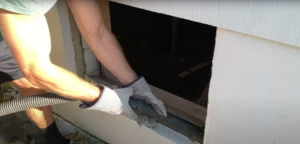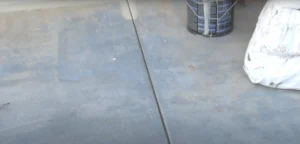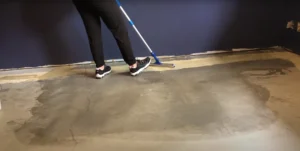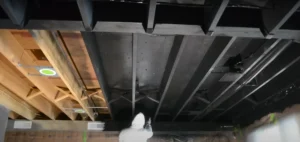Unfinished basement stairs can make your home look incomplete and create safety hazards. Many homeowners wonder, “How To Finish Basement Stairs” to improve both style and security.
Slippery treads and plain risers often make basement stairways unsafe and unattractive.
Finishing basement stairs enhances your basement’s appearance and reduces the risk of slipping and falling. This step-by-step guide on How To Finish Basement Stairs will walk you through easy, DIY-friendly methods.
From sanding and painting to adding carpet or vinyl, you’ll find the perfect solution for your space. Ready to upgrade your basement stairs? Let’s get started!
Key Takeaways
- Improve Safety and Look: Finishing basement stairs make your home safer by reducing slip hazards and enhances the overall appearance.
- Step-by-Step Process: The process includes sanding the stairs, cleaning them, filling any gaps, and choosing a finish like paint, stain, carpet, or vinyl.
- Use Safety Gear: Always wear a respirator, eye protection, and ear protection when sanding to stay safe.
- Concrete Floor Finish: You can also finish concrete basement floors by checking for moisture, cleaning, and applying paint, stain, epoxy, or vinyl for protection.
- Timeline: Finishing a basement typically takes 4 to 8 weeks, but larger or more complex projects can take up to 12 weeks.
Preparing Your Basement Stairs
Start by sanding your basement stairs to remove any rough spots. Then, clean them well to eliminate dust and prepare for the finish.
Sanding and Cleaning
Proper sanding and cleaning are essential for finishing your basement stairs. These steps ensure a smooth and polished staircase.
- Wear Safety Gear: Use a respirator, eye protection, and ear protection to stay safe while sanding.
- Remove Carpet: Start by taking off any carpet from the top of the stairs to prepare the wooden surfaces.
- Use a Random Orbital Sander: Smooth the wooden stair treads and risers with a random orbital sander for an even finish.
- Select Appropriate Sandpaper Grits: Use different grits of sandpaper to handle various surfaces and achieve the best results.
- Apply Wood Filler: Fill any holes or gaps in the stair stringers with wood filler for a flawless appearance.
- Hand Sand Spindles Carefully: Sand the spindles by hand to avoid damaging the intricate designs and ensure durability.
Finishing Options for Basement Stairs
Choose to paint, stain, or carpet your basement stairs to enhance their look—explore the best options below!
Painting or Staining
Start by sanding your basement staircase to smooth the surface. Clean off any dust and debris before you begin. Apply pre-stain wood conditioner to ensure even color. Choose a stain that matches your home improvement style.
Stain is permanent, so handle it carefully. After staining, apply polyurethane to protect the wood from foot traffic. If you prefer painting, use porch and floor enamel for durability.
Paint the risers and treads with your chosen color. Testing paint colors on a small area first is a good idea to see how they look.
A fresh coat of paint or stain can transform your basement stairs, adding both style and protection.
Installing Carpet or Vinyl
Choose carpet or vinyl to finish your basement stairs. Measure each step and clean them thoroughly. For carpet, attach padding using a stapler. Lay a carpet runner to protect against a lot of foot traffic.
When using vinyl, cut the planks with a jigsaw to fit each tread and riser. Apply construction adhesive for a strong bond. Fasten the vinyl in the corners and edges to keep it secure.
Use a caulk gun, tape measure, and drill for the installation. Ensure every stair is level before finishing to make your basement stair remodel look complete.
Caring for Your Finished Basement Stairs
Protect your basement stairs from heavy foot traffic and moisture. Choose a durable finish for the treads, risers, and railing. Paint with quality porch or floor enamel for a strong, lasting coat.
Synthetic carpets offer both style and durability, while luxury vinyl flooring provides waterproofing and safety. Reapply polyurethane every one to two years to keep the finish strong.
Regular maintenance helps cover basement stairs and preserves their look and function.
Keep an eye on any worn-out areas and address them quickly. Clean stains and spills to prevent mold growth. Use a nail gun carefully when fixing any parts to maintain the wooden risers and treads.
By following these care steps, your finished basement stairs will stay attractive and safe for your family to use.
Conclusion
Ready to upgrade your basement stairs? A few simple steps can make a big difference. Choose your favorite finish and get started today. Enjoy a safer and stylish basement space. Happy renovating!
FAQs
1. What are the best ways to finish basement stairs?
There are affordable ways to finish your basement stairs. Use plywood for new treads and add tread nosing for safety. Apply a clear finish or paint to make them look good. Poplar wood or polyvinyl chloride are great choices. This do-it-yourself project lets you start at the bottom and work up.
2. How do I install new treads on basement steps?
First, measure each step in inches. Saw to cut plywood or poplar boards to the right size. Use staples as fasteners to secure the treads. Add tread nosing to the front edge for safety. Finish with coats of clear or latex paint. This DIY basement project improves your set of stairs.
3. What materials do I need for a do-it-yourself basement stair renovation?
For a DIY basement stair renovation, gather plywood or poplar for new treads, polyvinyl chloride for durability, staple fasteners, and sheetrock for edges. You will also need a clear finish or latex paint, a saw to cut materials, and adhesive for the backer. Starting at the bottom set of stairs helps manage the project.
4. How can I make my basement stairs paintable?
To make your basement stairs paintable, start by sanding them smooth. Use a primer on plywood or poplar treads. Apply multiple coats of clear finish or latex paint for a smooth look. Add tread nosing to protect the front edge. Finishing your stairs this way gives a professional appearance and is a good idea for durability.
5. Is using polyvinyl chloride a good idea for basement steps?
Yes, using polyvinyl chloride (PVC) for basement steps is a good idea. PVC is durable and water-resistant, perfect for basement renovations. It can be used for tread nosing or as a top layer on new treads. This material is affordable and easy to install with staple fasteners. It also provides a clear finish that matches any design.
6. What are some affordable ways to finish stairs to open up my basement?
Affordable ways to finish stairs include using plywood for new treads and adding poplar trim. Apply a clear finish or paintable latex for a clean look. Install tread nosing on the front edge for safety. Choose do-it-yourself methods to save money. These steps enhance basement steps and create an open basement feel without expensive options.





